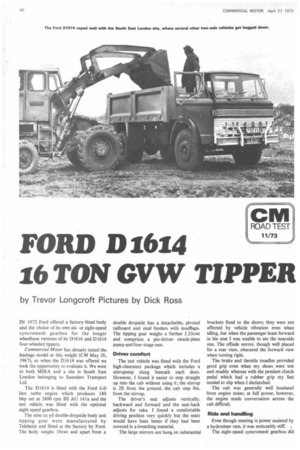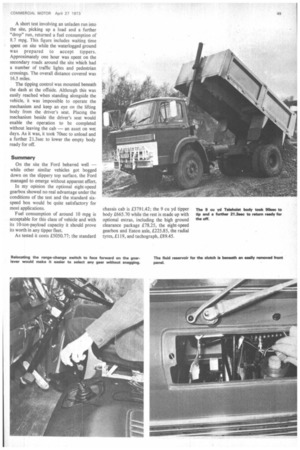FORD D1614 16 TON GVW TIPPER
Page 48

Page 49

Page 51

If you've noticed an error in this article please click here to report it so we can fix it.
by Trevor Longcroft Pictures by Dick Ross
IN 1972 Ford offered a factory-fitted body and the choice of its own sixor eight-speed syncromesh gearbox for the longer wheelbase versions of its D1616 and D1614 four-wheeled tippers.
Commercial Mo'or has already tested the haulage model at this weight (CM May 26, 1967), so when the D1614 was offered we took the opportunity to evaluate it. We went to both MIRA and a site in South East London belonging to Saunders Transport Ltd.
The D1614 is fitted with the Ford 6,0litre turbo engine which produces 140 bhp net at 2400 rpm BS AU 141a and the test vehicle was fitted with the optional eight-speed gearbox.
The nine cu yd double-dropside body and tipping gear were manufactured by Telehoist and fitted at the factory by Ford. The body weighs 19cwt and apart from a double dropside has a detachable, pivoted tailboard and steel fenders with mudflaps. The tipping gear weighs a further 5.25cwt and comprises a pto-driven swash-plate pump and four-stage ram.
Driver comfort
The test vehicle was fitted with the Ford high-clearance package which includes a stirrupstep slung beneath each door. However, I found it easier to step straight up into the cab without using it; the stirrup is 2ft from the ground, the cab step Sin. from the stirrup.
The driver's seat adjusts vertically, backward and forward and the seat-back adjusts for rake. I found a comfortable driving position very quickly but the seats would have been better if they had been covered in a breathing material.
The large mirrors are hung on substantial
brackets fixed to the doors; they were not affected by vehicle vibration even when idling, but when the passenger leant forward in his seat I was unable to see the nearside one. The offside mirror, though well placed for a rear view, obscured the forward view when turning right.
The brake and throttle treadles provided good grip even when my shoes were wet and muddy whereas with the pendant clutch pedal which had a rubber grip my feet tended to slip when I declutched.
The cab was generally well insulated from engine noise; at full power, however, the engine made conversation across the cab difficult.
Ride and handling
Even though steering is power assisted by a hydrosteer ram, it was noticeably stiff. The eight-speed syncromesh gearbox did not, in my opinion, prove as easy to handle as a constant-mesh one. The box is based • on a conventional four-speed gate; a change to high range is made by flicking a lever on the gear knob and then progressing through the ratios from fifth to eighth gear repeating the first to fourth change sequence of the lower range.
The baulking mechanism was stiff and rather more effort than one would expect for a synchromesh box was required to engage gear. Doubling the clutch eased the change. The range change is pneumatic, preselection being required in fourth or fifth gears for changing up or down respectively. The change worked smoothly though the select lever was badly placed; when changing from sixth to seventh I sometimes inadvertently flicked over the range switch.
On site, the 10.71 to I first ratio was too low and better progress was obtained using either second or third. Fully laden the Ford pulled away comfortably on a level road in third gear; first and second were only needed to pull away on steeper gradients. Fourth was very close to both third and fifth, consequently it was often easier to miss it during the gear-change sequence.
It would be interesting to compare the performance of the test vehicle with one fitted with the six-speed box — wide or close ratio boxes are available. For the most part only seven of the eight ratios were used and with a different specification the six-speed box might be better.
Performance
Unlike the lighter tipper models, both the D1614 and D1616 feature a full-air brake system. However, compared to other 16-tonners tested the figures obtained were not among the best. A full-pressure stop from 30 mph brought the vehicle to rest after 7I.3ft and from 40 mph after 133.3ft. Maximum efficiencies (Tapley meter) were 68 per cent and 63 per cent respectively. The primary brake system is in fact two circuits, one to the front axle and one to the rear — so if one should fail, the other remains operational. However, should both fail Ford has incorporated two-axle emergency braking on the handbrake. The handbrake is mechanically linked to the rear axle, while air is fed to the diaphragms at the front axle to activate the brakes. An emergency stop from 20 mph returned a maximum efficiency on the Tapley meter of 63 per cent. On a 1 in 4 gradient the park brake held the vehicle facing both up and down.
Restarts were Completed in first and reverse gears on the 1 in 4 gradient and the Ford just failed to climb the 1 in 3. Accelerating through the gears the D1614 reached 40 mph in 48.5sec and 50 mph in 84.6sec.
The British Standard 3425:1966 for measurement of noise emitted by motor vehicles requires the vehicle to be accelerated under certain conditions including having the vehicle unladen. The Ford was laden so we adopted our own test procedure, and the vehicle was driven in both directions past a noise meter, in third, fourth and fifth ratios. In each ratio the vehicle was accelerated from three-quarters of the engine-governed speed. The highest reading, 84dBA, was achieved in fourth gear accelerating from 12 mph. This figure is 5dBA less than the permitted maximum.
Motorway fuel consumption was taken over the 37-mile stretch between the Watford Gap and Hemel Hempstead. Throughout the run the road was clear and a high average speed of 53 mph was achieved. For much of the time the top speed of 58 mph was maintained and only a few changes into seventh were needed for the steeper sections.
A short test involving an unladen run into the site, picking up a load and a further "drop" run, returned a fuel consumption of 8.7 mpg_ This figure includes waiting time spent on site while the waterlogged ground was prepared to accept tippers. Approximately one hour was spent on the secondary roads around the site which had a number of traffic lights and pedestrian crossings. The overall distance covered was 16.5 miles.
The tipping control was mounted beneath the dash at the offside. Although this was easily reached when standing alongside the vehicle, it was impossible to operate the mechanism and keep an eye on the lifting body from the driver's seat. Placing the mechanism beside the driver's seat would enable the operation to be completed without leaving the cab — an asset on wet days. As it was, it took 70sec to unload and a further 21.3sec to lower the empty body ready for off.
Summary On the site the Ford behaved well — while other similar vehicles got bogged down on the slippery top surface, the Ford managed to emerge without apparent effort.
In my opinion the optional eight-speed gearbox showed no real advantage under the conditions of the test and the standard sixspeed box would be quite satisfactory for most applications.
Fuel consumption of around 10 mpg is acceptable for this class of vehicle and with its 10-ton-payload capacity it should prove its worth in any tipper fleet.
As tested it costs £5050.77; the standard chassis cab is £3791.42; the 9 cu yd tipper body £665.70 while the rest is made up with optional extras, including the high ground clearance package £78.25, the eight-speed gearbox and Eaton axle, £225.85, the radial tyres, £119, and tachograph, £89.45.












































































































